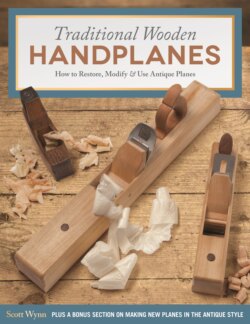Sew-It-Yourself Home Accessories

Реклама. ООО «ЛитРес», ИНН: 7719571260.
Оглавление
Scott Wynn. Sew-It-Yourself Home Accessories
ACKNOWLEDGEMENTS
CONTENTS
INTRODUCTION
The criteria
CHAPTER. 1. ANATOMY OF THE TRADITIONAL HANDPLANE. A SIMPLE DESIGN
THE BLADES
CHIPBREAKERS
THE WEDGE
THE BLOCK
HANDLES
AND A WORD ABOUT CHINESE-STYLE PLANES..
CHAPTER. 2. SHARP. BLADE STEEL
BASIC BLADE CRITERIA
ANATOMY OF STEEL
Grain
Structure
Hardness
TYPES OF EDGE STEEL
Carbon steel
Alloy steel
High-speed steel
MY RECOMMENDATION
CHAPTER. 3. HOW A PLANE WORKS. THE SIX TACTICS USED TO ACHIEVE BEST PERFORMANCE
1. THE ANGLE OF THE BLADE
Traditional blade angles
The best blade angle
Blade angle and the task
Custom blade angles
2. MOUTH OPENING
Adjusting the mouth opening
3. CHIPBREAKER
Setting the chipbreaker
4. BEVEL ANGLE
5. SHAPE OF THE BLADE EDGE
PLANES WITHOUT A CHIPBREAKER
PLANES WITH A CHIPBREAKER
6. LENGTH OF PLANE/WIDTH OF BLADE
And remember…
CHAPTER. 4. TRADITIONAL USE: THE BENCH PLANES. JACK, JOINTER & SMOOTHER—AND A COUPLE MORE USEFUL PLANES
THE JACK PLANE
What to look for in a jack
THE JOINTER PLANE
What to look for in a jointer plane
Can you get by without a jointer plane?
SMOOTHING PLANES
What to look for in a smoothing plane
A COUPLE MORE PLANES
The panel plane
The scrub plane
DIMENSIONING STOCK
Preparing the first face: scrub and jack planes
Continuing with the jointer plane
Smoothing the first face
Planing the edges and second side
OTHER HANDPLANE PREPARATORY WORK
SHOOTING AN EDGE
Tips for shooting an edge
CHAPTER. 5. SHARPENING PLANE BLADES. A BASIC SKILL THAT LEADS TO OTHERS
Jig drawbacks
BEVEL SHAPE
GRINDING
Alternatives
SHARPENING STONES
TECHNIQUE
CHAPTER. 6. HOLDING THE WORK. OF SLAVES, DOGS, AND DEADMEN
Simple stop
Adding versatility
Deadmen and helper boys
Bench dogs
CHAPTER. 7. SETTING UP THE PLANES. AND TUNING THEM TO WORK TO THEIR FULLEST
SETTING UP A TRADITIONAL WOODEN PLANE
1. Inspect the plane: old planes
1A. Inspect the plane: new planes
2. Prepare the blade
3. Prepare the chipbreaker
4. Bed the blade properly
5. Configure the sole
Doing the work
6. Adjust the Mouth
7. Attend to the details of the body and sole
8. Attend to the details of the grip and finish
SETTING UP CHINESE PLANES
1. Inspect the plane
5. Configure the sole
6. Adjust the mouth
7. Attend to the details of the body and sole
8. Attend to the details of the grip and finish
TROUBLESHOOTING
CHAPTER. 8. MAKING & MODIFYING PLANES. EXPANDING YOUR OPTIONS
MAKING TRADITIONAL WOODEN-BODY PLANES
The planes
Materials. BLADES
BLOCK
Making the planes. 1. ROUGH MILL THE BLOCKS AND GLUE-UP THE SOLE PLATES
2. LAY OUT AND DRILL
3. MAKE JIGS
4. CUT THE BLADE BED AND THROAT OPENING
5. SOLE PLATE
6. CROSS PIN
7. WEDGE
8. FINISH FITTING THE SOLE PLATE
9. SHAPING THE SMOOTHING PLANES
10. MAKE AND FIT THE TOTES
11. FINISHING TOUCHES
Отрывок из книги
To my father, Jerry, who taught me always to watch and listen; and to my daughter, Josephine, who stands on her grandfather’s shoulders watching, listening, and learning—and teaching all of us.
I would also like to acknowledge the untiring support of Kathy Tam, the helpful guidance of technical editor Rick Mastelli, and the encouragement and long hours of Jerry Konicek, whose Woodworking Academy gave me the opportunity to verify and refine my techniques.
.....
Chinese Smoothers
Why a Narrow Smoother?
.....